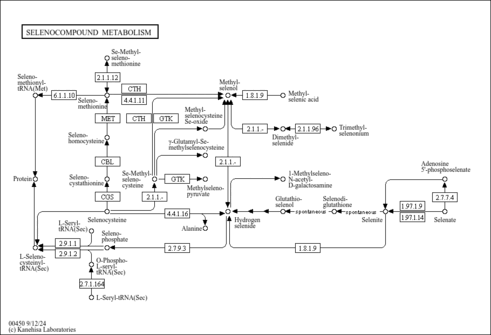Mrv1652305171806002D
4 3 0 0 0 0 999 V2000
0.8250 0.0000 0.0000 Se 0 0 0 0 0 4 0 0 0 0 0 0
1.2375 0.7145 0.0000 O 0 0 0 0 0 0 0 0 0 0 0 0
1.2375 -0.7145 0.0000 O 0 0 0 0 0 0 0 0 0 0 0 0
0.0000 0.0000 0.0000 O 0 0 0 0 0 0 0 0 0 0 0 0
1 2 2 0 0 0 0
3 1 1 0 0 0 0
4 1 1 0 0 0 0
M END
> <DATABASE_ID>
HMDB0011119
> <DATABASE_NAME>
hmdb
> <SMILES>
O[Se](O)=O
> <INCHI_IDENTIFIER>
InChI=1S/H2O3Se/c1-4(2)3/h(H2,1,2,3)
> <INCHI_KEY>
MCAHWIHFGHIESP-UHFFFAOYSA-N
> <FORMULA>
H2O3Se
> <MOLECULAR_WEIGHT>
128.97
> <EXACT_MASS>
129.916915758
> <JCHEM_ACCEPTOR_COUNT>
4
> <JCHEM_ATOM_COUNT>
6
> <JCHEM_AVERAGE_POLARIZABILITY>
5.839589010021143
> <JCHEM_BIOAVAILABILITY>
1
> <JCHEM_DONOR_COUNT>
2
> <JCHEM_FORMAL_CHARGE>
0
> <JCHEM_GHOSE_FILTER>
0
> <JCHEM_IUPAC>
selenous acid
> <JCHEM_LOGP>
-1.2765
> <JCHEM_MDDR_LIKE_RULE>
0
> <JCHEM_NUMBER_OF_RINGS>
0
> <JCHEM_PHYSIOLOGICAL_CHARGE>
-2
> <JCHEM_PKA>
6.80102999566398
> <JCHEM_PKA_STRONGEST_ACIDIC>
1.1989700043360187
> <JCHEM_POLAR_SURFACE_AREA>
57.53
> <JCHEM_REFRACTIVITY>
19.686999999999998
> <JCHEM_ROTATABLE_BOND_COUNT>
0
> <JCHEM_RULE_OF_FIVE>
1
> <JCHEM_TRADITIONAL_IUPAC>
selenious acid
> <JCHEM_VEBER_RULE>
0
$$$$
